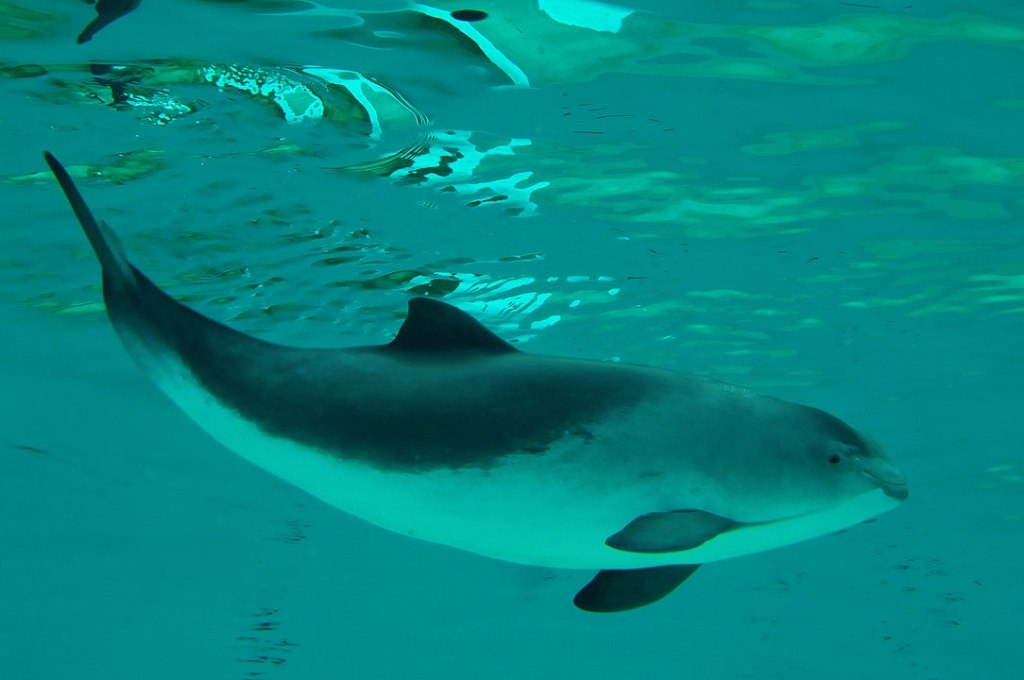
It seems almost inconceivable that the porpoise – a type of small dolphin – would ever have been eaten, but it was once a most high-status ingredient. Although it is obviously a mammal, in the Middle Ages it was considered a fish, and therefore it could be eaten on fast days (all of the cetaceans were ‘fish’ as were seals and beavers’ tails) and it was usually served on fish days as a substitute for venison, another very high-status meat.[1] It seems that this was a bit of a blip for Europe: for the last few centuries, as well as in antiquity, dolphins have been very much considered a ‘friend of man’, and not an animal that should be eaten, not so in the Middle Ages.[2] The word porpoise comes from the Old French words porcus and piscus: ‘pigfish’ They have also gone by the names ‘mere-swine’ and ‘seahog’[3] and were eaten at the poshest of posh feasts. When George Neville celebrated becoming Archbishop of York in 1466, he held a huge feast, inviting 2000 guests of very high rank, the fish course was made up of 608 bream and pike, and 12 porpoise and seal.[4]
There were several ways of preparing it; if fresh it was poached and served in slices. In the late 14th century manuscript Forme of Cury, it is served with frumenty.[5] Sometimes it was cooked in a broth with wine, vinegar, bread, onions and its own blood.[6] It was also salted and cooked with dried peas and beans, rather like salt pork. If tip-top fresh, ‘porpesses must be baked’. The carving term for a baked porpoise is ‘undertraunche’[7], and it is served dressed with vinegar, cinnamon and ginger.[8]
The earliest mention of a porpoise hunt occurring in the British Isles comes from the 7th century just off the Irish coast by ‘foreigners’ most probably Vikings. The 10th century manuscript Ælfric’s Colloquy does mention the hunting of dolphins[9] and when we tick into the 11th century – during the reign of Æthelred II (the Unready) – there are rolls listing fisheries in Gloucester which specialised in fishing for them. Just one porpoise is mentioned in the Domesday Book – it was paid as geld at an estate in Kent. Post-conquest, they appear more frequently in ordinances for example: 10 people were supplied for Henry III in 1256 at the Feast of St. Edward – a feast that always occurs during Lent.[10]

Kongelige Bibliotek, Gl. kgl. S. 1633 4º, Folio 60v)
One does have to wonder how much luck was needed when it came to ‘hunting’ them because the majority of them seem to have been opportunistically acquired after the poor beasts were found beached. One, therefore, also has to wonder just how fresh these porpoises were when delivered to a noble’s kitchen. I suspect that they were very quickly salted down and stored until there were ordered. There were laws laid down as to who owned the poor creatures after they were found beached; for most of the Middle Ages they were considered ‘wrecks of the sea’, so it was a case of finders’ keepers, but in the 13th and 14th centuries – the period when eating porpoises reached its peak – it was asserted that all beached porpoises belonged to the Crown.[11]
The number of porpoises consumed really drops in the Early Modern Era: Henry VIII was gifted a porpoise at Calais in 1532, and in 1575 (during the reign of Elizabeth I) one appeared for sale at Newcastle Market. After that, mentions of porpoises as food seem to dry up.[12]
If you are a historical cook, you might be wondering what you could substitute if you wanted to recreate a dish containing porpoise for a medieval menu. Historian Peter Brears has one fine suggestion: use a large piece of the freshest, firmest and largest block of tuna you can afford![13]
If you like the blogs and podcast I produce and would to start a £3 monthly subscription, or would like to treat me to virtual coffee or pint: follow this link for more information. Thank you.
[1] Brears, P. (2012). Cooking & Dining in Medieval England. Prospect Books.
[2] Davidson, A. (1999). The Oxford Companion to Food. Oxford University Press.
[3] Gardiner, M. (1997). The Exploitation of Sea-Mammals in Medieval England: Bones and their Social Context. Archaeological Journal, 154(1). https://doi.org/10.1080/00665983.1997.11078787; The Shuttleworth Family. (1858). The House and Farm Accounts of the Shuttleworths of Gawthorpe Hall, in the County of Lancaster, at Smithils and Gawthorpe From September 1582 to October 1621 · Part 4 (J. Harland, Ed.). The Chetham Society.
[4] Brears (2012)
[5] Frumenty: a whole wheat ‘risotto’, ‘messe it with porpays’, says Forme of Cury.
[6] Hieatt, C. B., & Butler, S. (1985). Curye on Inglysch: English culinary manuscripts of the fourteenth century. Oxford University Press.
[7] In the Middle Ages each animal served at table had its own carving term: so one doesn’t carve a porpoise, one ‘undertraunches’ it.
[8] Brears (2012); Furnivall, F. J. (1931). Early English Meals and Manners. Forgotten Books.
[9] It also states that whales should not be hunted: far too dangerous. Read a translation online here: https://pdf4pro.com/amp/view/aelfric-s-colloquy-translated-from-the-latin-by-2a9241.html
[10] Gardiner (1997)
[11] Ibid.
[12] The Shuttleworth Family (1858)
[13] Brears (2012)

Pingback: 6 January 1864 | Mermaid 1864